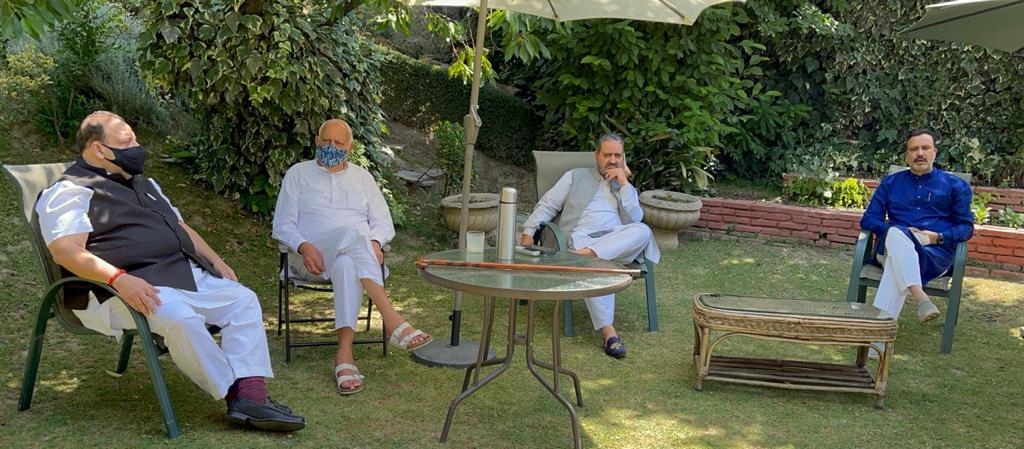
Desertions of the leaders from the PDP and now the National Conference isn’t just about party-hopping in search of better career prospects but about a political makeover of Kashmir
IN a recent statement, former union minister Saif-u-Din Soz said that “a knowledgeable source,” in New Delhi told him that the exit of Devender Singh Rana from the National Conference was “a tip of the iceberg” of “Modi’s Kashmir plan.” Though Soz didn’t elaborate, he nevertheless let on that Delhi had a “larger plot,” and “a sub-plan of dealing with border areas like Karnah, Keran, Gurez, Tulail, Kargil and Ladakh areas.”
What is this Kashmir plan? Or if at all there is one. Soz has given fewer specific details, while quoting his source. But whatever the merit of the information allegedly possessed by the Soz’s source, the truth is that the far-reaching changes are certainly afoot in Kashmir over the last over two years. So much so that, in hindsight, the withdrawal of Article 370 seems but an event.
Ever since the Narendra Modi government stripped J&K of its semi-autonomous status in August last, the decision has invariably been explained as the outcome of the BJP’s push to fulfill its long-standing ideological agenda and electoral promise. It was certainly about that but only in a rhetorical sense. In its implementation on the ground since then, the decision has come across as an elaborate and minutely thought through plan of action that seeks to fundamentally alter the facts on the ground to end the lingering conflict on this side of the Line of Control’. And in that sense, the withdrawal of the former state’s special status and the actions undertaken over the last year form an ambitiously envisioned alternative settlement formula for Kashmir.
This formula is not about resolving the Kashmir issue as we know it: a dispute between India and Pakistan going back to Partition and the one arising from a decades-long separatist struggle in the region. There is no plan underway to talk to Pakistan or to the dissenting political and militant groups in J&K to arrive at a solution. That is, except on New Delhi’s terms. On the contrary, the effort is to enforce a solution – a merger of J&K into India – without necessarily taking Kashmiris or Pakistanis on board.
The BJP has made no secret of its desire to enhance the number of Assembly seats to the Jammu region. Before J&K’s bifurcation into two union territories – J&K and Ladakh – its Assembly had 87 seats of which predominantly Muslim majority Kashmir Valley had 47 seats, Hindu majority Jammu 37 and the now separated Ladakh with a slim Muslim majority 4 seats. Now according to the delimitation, that in the normal course was due to be held in 2026, seven new seats are being added to the Assembly, most of which, if not all, are expected to go to Jammu.
This has the potential to shift the region’s political center away from Kashmir Valley to Jammu division. The latter could very well become an equal stakeholder in future J&K governance, unlike the existing Kashmir-dominated political structure that is largely perceived to be playing to separatist sentiment in the Valley and parts of Muslim dominated areas of Jammu.
These are ambitious aims and the BJP knows it. That is why it revoked the Article 370 within the first three months of its second term so that it gets sufficient time to implement the plan. Over the last year, Modi government has been in a hurry to bring one after another legislative and administrative measure to cast Kashmir in a premeditated image, the PM Modi has called Naya Kashmir.
So, contrary to expectations among some sections of people in Kashmir, the statehood for J&K may not be restored anytime soon. The reason is this gives the central government direct control over the region and, in turn, freedom to make any administrative or legislative changes to accomplish its goal within the timeframe of its ongoing tenure.
Desertions of leaders from the PDP and now the National Conference thus snugly slots into the new scheme of things. It isn’t just about party-hopping in search of better career prospects and the parties that are perceived to somehow enjoy New Delhi’s blessings. It is about an attempt at a political makeover of the place, not from the ground up but from the top-down. And in Rana’s case, this intervention is seen to have moved to its second level. More than an ordinary career move, Rana’s exit from the NC has a finer message written all over it: it is about Jammu’s new-found political centrality in J&K politics which the anticipated award of more legislative seats to the division by the Delimitation Commission will reinforce and cement. And in this new J&K, instead of Abdullahs and Muftis, it is the Rana brothers that will hog the light and probably rule.
Views expressed in the article are the author’s own and do not necessarily represent the editorial stance of Kashmir Observer
Follow this link to join our WhatsApp group: Join Now
Be Part of Quality Journalism |
Quality journalism takes a lot of time, money and hard work to produce and despite all the hardships we still do it. Our reporters and editors are working overtime in Kashmir and beyond to cover what you care about, break big stories, and expose injustices that can change lives. Today more people are reading Kashmir Observer than ever, but only a handful are paying while advertising revenues are falling fast. |
| ACT NOW |
| MONTHLY | Rs 100 | |
| YEARLY | Rs 1000 | |
| LIFETIME | Rs 10000 | |










